What is Carpal Tunnel Syndrome (CTS)?
Carpal Tunnel Syndrome occurs when the median nerve, which controls sensations in the thumb, index, middle, and part of the ring fingers, becomes compressed or pinched at the wrist. The carpal tunnel is a narrow passageway made up of bones and ligaments, and it houses not only the median nerve but also tendons that control finger movements. When this tunnel becomes narrowed or the tendons become swollen, pressure is exerted on the median nerve, causing the symptoms associated with CTS.
This condition is often seen in individuals who perform repetitive tasks that involve wrist movements, such as typing, using a mouse, or assembly-line work. However, CTS can also result from injury, pregnancy, or underlying health conditions like diabetes or arthritis.
Causes of Carpal Tunnel Syndrome
CTS is commonly caused by a combination of genetic, lifestyle, and environmental factors. Some of the most common causes and risk factors include:
- Repetitive Hand Movements: Activities that require frequent and repetitive wrist movements, such as typing, writing, or using a mouse, can put excess pressure on the carpal tunnel, leading to CTS over time.
- Injury or Trauma: Any injury or trauma to the wrist, such as a fracture or sprain, can narrow the carpal tunnel and compress the median nerve, leading to CTS.
- Health Conditions: Conditions like diabetes, rheumatoid arthritis, and thyroid disorders can increase the risk of developing CTS. These diseases may lead to swelling, inflammation, or changes in the structure of the carpal tunnel, putting pressure on the median nerve.
- Pregnancy: Hormonal changes during pregnancy, especially in the third trimester, can lead to fluid retention, which may cause swelling around the carpal tunnel, contributing to CTS.
- Obesity: Being overweight can increase the pressure on the carpal tunnel, contributing to the development of CTS.
- Genetics: Some people may be genetically predisposed to developing Carpal Tunnel Syndrome, due to the natural shape and size of their carpal tunnel.
Symptoms of Carpal Tunnel Syndrome
CTS typically develops gradually, and its symptoms may worsen over time. Common symptoms of Carpal Tunnel Syndrome include:
- Numbness and Tingling: This is often the first sign of CTS. Individuals may experience tingling, especially in the thumb, index, middle, and part of the ring finger. The sensation is often described as “pins and needles” and may occur when the hands are at rest, especially at night.
- Pain: Pain may be felt in the wrist, hand, or forearm. The pain can range from mild to severe and may worsen with activity. In some cases, the pain can extend up to the elbow or shoulder.
- Weakness: Weakness in the hand, especially in the grip, is common. You may find it difficult to perform everyday tasks, such as holding a pen, turning a doorknob, or lifting objects.
- Clumsiness: Due to the combination of numbness and weakness, some people with CTS experience a loss of dexterity and coordination in their hands. This can make tasks like typing, writing, or handling small objects more challenging.
- Worsening Symptoms at Night: Many people with Carpal Tunnel Syndrome report that their symptoms are worse at night, possibly due to wrist flexion during sleep.
Diagnosing Carpal Tunnel Syndrome
If you suspect you have Carpal Tunnel Syndrome, it is crucial to see a healthcare provider for an accurate diagnosis. Your doctor will typically begin by conducting a thorough physical examination, checking for signs of weakness, numbness, or tingling in the hands and fingers.
Diagnostic Tests for CTS:
- Phalen’s Maneuver: This test involves bending the wrists forward for a minute to see if it triggers symptoms like tingling or numbness. If symptoms appear during this test, it may indicate CTS.
- Tinel’s Sign: The doctor may tap over the median nerve at the wrist. If this causes tingling or electric shock-like sensations in the fingers, it could be a sign of CTS.
- Nerve Conduction Studies (NCS): This test measures how well electrical signals pass through the median nerve. Slower conduction speeds can confirm the diagnosis of CTS.
- Electromyography (EMG): EMG is used to assess the electrical activity in the muscles and determine if there is any nerve damage caused by Carpal Tunnel Syndrome.
- Ultrasound: In some cases, ultrasound imaging may be used to visualize the carpal tunnel and detect any swelling or abnormalities.
Treatment for Carpal Tunnel Syndrome
Treatment for CTS depends on the severity of the condition. In mild cases, conservative measures can help relieve symptoms, while more severe cases may require surgical intervention.
Conservative Treatments:
- Wrist Splints: Wearing a wrist splint, especially at night, can help keep the wrist in a neutral position, reducing pressure on the median nerve. This can alleviate symptoms and prevent further damage.
- Rest and Activity Modification: Resting the affected hand and wrist and avoiding activities that exacerbate symptoms is crucial. Taking frequent breaks from repetitive tasks can help reduce strain on the carpal tunnel.
- Physical Therapy: Physiotherapy can help strengthen the muscles in the wrist and hand, improve range of motion, and reduce swelling. Therapists may use stretches, exercises, and manual therapy techniques to alleviate pain and improve function.
- Medications: Nonsteroidal anti-inflammatory drugs (NSAIDs), such as ibuprofen, can help reduce inflammation and relieve pain. Corticosteroid injections may also be used to reduce swelling and pressure on the median nerve.
- Ergonomic Modifications: Adjusting your workstation to maintain proper posture and wrist alignment can significantly reduce the risk of developing CTS. Ergonomic keyboards, mouse placement, and wrist rests can help improve comfort and reduce strain.
Surgical Treatment:
If conservative treatments do not alleviate symptoms, or if the condition is severe, surgery may be necessary. The goal of surgery is to relieve pressure on the median nerve by cutting the ligament that forms the roof of the carpal tunnel.
- Carpal Tunnel Release Surgery: This is the most common surgical treatment for Carpal Tunnel Syndrome. It can be performed as an open surgery or using a minimally invasive endoscopic procedure. The surgery aims to widen the carpal tunnel and reduce pressure on the median nerve.
- Post-Surgery Rehabilitation: After surgery, physical therapy is often required to restore hand function, strength, and flexibility. It may take several weeks to months to fully recover from carpal tunnel release surgery.
Other Related Article for reading
Frozen Shoulder Relief: Restore Movement and Comfort
Physiotherapy Treatment for Carpal Tunnel Syndrome (CTS)
Carpal Tunnel Syndrome (CTS) can be treated effectively through physiotherapy, particularly when diagnosed early. Physiotherapists aim to reduce pressure on the median nerve, improve wrist function, and alleviate pain and discomfort through exercises, manual therapy, and ergonomic adjustments.
Below is a breakdown of physiotherapy treatments for CTS, along with the exercises and techniques typically used.
1. Wrist Splints
Objective: Rest and reduce pressure on the median nerve.
- Treatment: Physiotherapists often recommend wearing a wrist splint at night to maintain a neutral wrist position. This prevents bending or compressing the carpal tunnel while you sleep, providing relief from symptoms.

2. Nerve Gliding Exercises
Objective: To improve the movement of the median nerve and reduce irritation.
- Treatment: Nerve gliding exercises are designed to gently move the median nerve through the carpal tunnel, helping to reduce nerve entrapment and improve flexibility.
Example Exercise: Median Nerve Glide
- Start Position: Begin by extending your arm in front of you with your wrist fully bent backward (fingers pointing toward the ceiling).
- Action: Slowly straighten the elbow and bring the wrist back to a neutral position, gently moving your hand away from your body.
- Repetition: Hold for 5-10 seconds, then relax. Perform this 10-15 times.
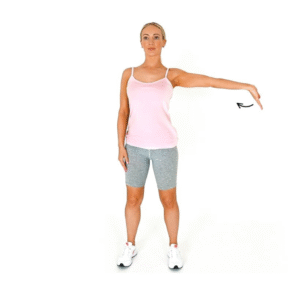
3. Tendon Gliding Exercises
Objective: To improve the movement and flexibility of the tendons in the carpal tunnel, reducing swelling and pain.
- Treatment: Tendon gliding exercises target the flexor tendons that run through the carpal tunnel. These exercises promote tendon movement and reduce tightness in the wrist and hand.
Example Exercise: Tendon Glide
- Start Position: Make a fist with your hand.
- Action: Slowly extend your fingers, one by one, then make a “claw” position by bending the fingers while keeping the knuckles straight.
- Repetition: Repeat 10-15 times for each hand.
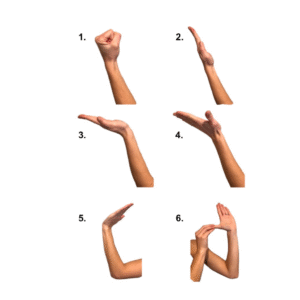
4. Wrist Stretching and Strengthening Exercises
Objective: To increase flexibility and strength in the wrist and forearm, alleviating the symptoms of CTS.
- Treatment: Physiotherapists may prescribe wrist stretches and strengthening exercises to improve the range of motion in the wrist and fingers, as well as to enhance muscle strength and endurance.
Example Exercise: Wrist Flexor Stretch
- Start Position: Extend your arm forward, palm facing upwards.
- Action: Gently bend your wrist downward using your other hand to apply light pressure, stretching the flexor muscles in the forearm.
- Repetition: Hold the stretch for 20-30 seconds, then relax. Repeat 3 times for each hand.
Example Exercise: Wrist Extension Stretch
- Start Position: Extend your arm forward with the palm facing down.
- Action: Use the opposite hand to gently bend the wrist upward, stretching the wrist extensors.
- Repetition: Hold the stretch for 20-30 seconds, then relax. Repeat 3 times for each hand.
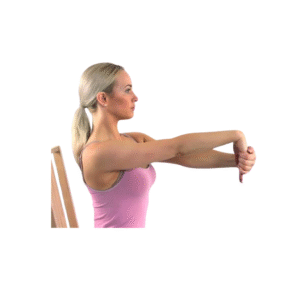
5. Soft Tissue Mobilization
Objective: To release tension in the wrist and forearm muscles, reducing pressure on the median nerve.
- Treatment: Soft tissue mobilization is a manual therapy technique where the physiotherapist applies gentle pressure to the muscles and soft tissues around the wrist. This technique helps to reduce muscle tightness and inflammation, which can alleviate symptoms of Carpal Tunnel Syndrome.

6. Ergonomic Advice and Modifications
Objective: To reduce strain and pressure on the carpal tunnel during daily activities.
- Treatment: Physiotherapists may offer ergonomic advice for your workspace or daily activities. This includes suggestions on how to modify your posture, wrist position, and workstation setup to reduce strain on the wrist.
Example Modifications:
- Adjusting the height of your chair and desk to ensure your wrists are not bent during typing.
- Using a split keyboard and an ergonomic mouse.
- Taking breaks to stretch your hands and wrists every 20-30 minutes.
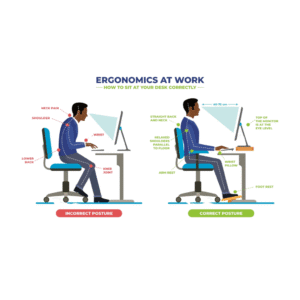
7. Hot and Cold Therapy
Objective: To reduce inflammation and manage pain.
- Treatment: Physiotherapists often recommend alternating hot and cold treatments for Carpal Tunnel Syndrome. Ice packs can reduce inflammation and swelling, while heat therapy helps to increase blood flow and relax muscles.
How to Use Heat and Cold Therapy:
- Apply ice packs for 10-15 minutes to reduce swelling and numb the area.
- Use a warm compress or heating pad for 15-20 minutes to help relax the wrist muscles.
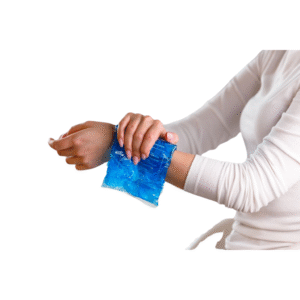
8. Ultrasound Therapy
Objective: To promote healing and reduce inflammation in the tissues around the carpal tunnel.
- Treatment: Ultrasound therapy uses sound waves to penetrate the skin and tissues, promoting healing and reducing pain and inflammation. It is often used for more severe cases of CTS to accelerate the recovery process.
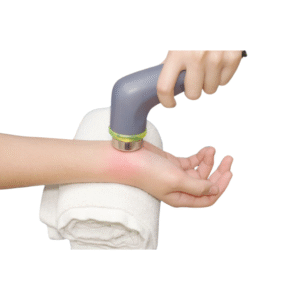
9. Posture Correction
Objective: To reduce wrist strain and improve overall body alignment.
- Treatment: Poor posture, especially during activities like typing or using a mouse, can contribute to Carpal Tunnel Syndrome. A physiotherapist will assess your posture and recommend exercises to improve spinal alignment, wrist positioning, and overall ergonomics.
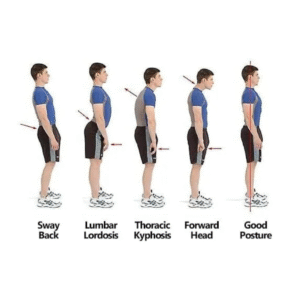
Preventing Carpal Tunnel Syndrome
While Carpal Tunnel Syndrome cannot always be prevented, certain measures can help reduce the risk or alleviate symptoms:
- Take Breaks: If you engage in repetitive activities, take regular breaks to stretch your wrists and hands. This helps to reduce strain and pressure on the carpal tunnel.
- Proper Ergonomics: Set up your workspace to promote proper wrist alignment. Use ergonomic devices, such as a split keyboard or vertical mouse, and maintain a neutral wrist position.
- Exercise and Stretching: Regularly perform hand and wrist exercises to strengthen the muscles and improve flexibility. Stretching can also help relieve tension and reduce the risk of injury.
- Avoid Prolonged Pressure: Avoid resting your wrists on hard surfaces for long periods of time, and be mindful of the positioning of your hands during activities.
- Maintain a Healthy Weight: Being overweight increases the pressure on the carpal tunnel. Maintaining a healthy weight can reduce the risk of developing Carpal Tunnel Syndrome.

